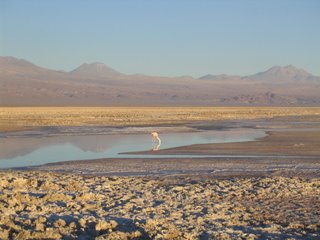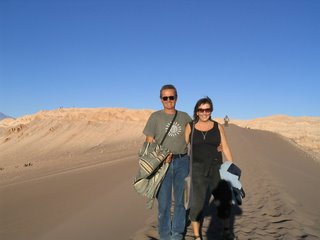Chile - Longest land, Longest day...


Tuesday 25 July is the longest day we have ever enjoyed. Up at 6, for a three hour flight down to Auckland from Fiji. Then 5 hours to hang around Auckland airport, which is quite easy really, especially as we find a free internet stand, it is standing, great for the next bit: 11 hours across the Pacific Ocean to Santiago. We leave Auckland at 5pm, teatime, and arrive at Santiago at 1pm , lunchtime, the same day! Aaaarghh! Brainless, we buy pesos, coffee, avoid the taxis and negotiate the local bus into the city centre...
Cold, grey drizzle accompanies us all the time in Santiago, but we warm to it. The hotels are not cheap, but everything else is. The hotel itself has a beautifully carved wooden staircase, high ceilinged rooms with narrow, tall doors in pairs, and staff who smile at our absolute lack of Spanish. We sleep and wander around Santiago, finding 2 excellent museums - one of pre-Columbian art in south and central America, the other a contemporary gallery sponsored by the Salvador Allende foundation - works that were stashed away for 17 years while Pinochet ruled the roost...
We never quite know what we will eat in Chile, (language), but we get a bean stew with floating sausage at lunchtime, and Jac has this salad at dinner - a pile of cold rice surrounded by heaps of cold chicken, cold ham, and a pile of cold cooked peppers! We learn that Énsalada´ means cold, not salad! Still, we manage to avoid food of the sort we photo´d for the ´Food´section of the blog! and we know we won´t go hungry!
We choose a 7 hour bus journey out of Santiago - north, its warmer! - to La Serena. The road north from Santiago takes us up through hills covered in light snow, cactii and almond trees, and then down to the coast through a rich green agricultural land. The Pacific pounds this rocky coastline and rolling surf greets the beaches. Single-storey houses, some on stilts, tin roofs like NZ, men and women waving white flags by the roadside to attract youto their cakes and drinks.
The land is green and the motorway empty, the bus is full and as comfy as any, and everywhere we go the Andes offer a white, distant backdrop.
La Serena is the second oldest city in Chile, and the locals declare the cleanest! We end up 5 nights here, courtesy of Maria, brother Pancho (a cobbler), and son Andres , who open up their house to backpackers, fuss over us, do our washing up despite protest, and generally point us in the right direction. Here we fight off colds: bright sunny days and cold nights, we peruse the museums, the Japanese gardens (not a bad effort!), stroll the beaches, eat fish soup at the port, and take a days tour inland to the Elqui Valley - learning all about Papaya and all its healing properties, Pisco - and all its properties, the Inca influence, the minerals, and the stars... Chile is mineral rich, and great import is given to the energies held within its mountains. Where we are now, its ´polar opposite´would be the Himalayas, which bit we wonder? People here since ancient times have used this mineral wealth for spiritual and esoteric purposes, now, of course, they`re rolling in it, and as copper prices shoot up the glitzy shopping malls are moving in. I didn`t expect to see the fast food outlets, multiplex cinemas and fashion stores in provincial Chile - but hey! everyone wants to shop! (it seems)
Our next journey will be an 18 hour bus ride up into the Andes, into the desert near Bolivia at San Pedro de Atacama. By 11pm we are rolling out of La Serena - these buses are something else - sleek monsters purring along endless roads, uniformed proud staff who fold every blanket so that the company motif only shows when stacked, and offer you biscuits and pop at mealtime.
At dawn, we awaken to a deep blue sky and miles of empty, barren, brown rock and dust, rolling as low hills into the distance. From now, until nearly 11 am when Antofagasta bursts upon us, I see ONE weed growing, no other form of life. Welcome to north Chile! Nearer to San Pedro our slumbering neighbours start to gasp and reach for the camera - salt flats and multi coloured plains dotted with shelves of rock formations surround us, and a small green oasis sits below us - San Pedro de Atacama, itself at nearly 2500 metres above sea level. (They,ve found marine fossils here!)
A few days are spent here - highlights included a night visit to a private observatory run by a French astronomer, Alain. Enthusiastically and wittily he guides us around the sky; we peer through his collection of telescopes at the moon and stars, and he debunks astrology in about 2 minutes (today, August the 3rd, the sun is actually in CANCER! - due to constellation movements over time!). Anyway, we learn a lot, red stars and blue stars, gaze at Alpha Centauri, have fantastic photos of the moon put on our digital camera; if interested check out
www.spaceobs.com When the Hubble telescope runs out of steam? power? commission? or whatever in 2010, then its replacement is being built in these hills, much more powerful...
Another day we take a tour off to Luna Valley, Death Valley and the salt caves - all self-explanetory geological marvels, and we watch a sunset from the top of a craggy peak that lights hundreds of miles of the Andes in a glowing crimson and scarlet. Quick fact for the gardeners:
average rainfall in San Pedro is 5-10 millimetres, per year!
An irrigation system much like the Andalucian izveccias runs thru the village and I spend two afternoons trying to locate the waters´source and end, to no avail, but a couple of interesting walks round the backs!
Our last night here was stupendous again - a somewhat mediocre afternoon tour ended up on the Chaxa salt lake - at sunset, with flamingos feeding and flying around us and all those technicolour Andean hues as the sun dipped down...
From here we had to go to Calama,1. to get money(not available in San Pedro) and 2. to fly to Santiago,but with a day in between to do the laundry, write some blog up (yaawn), and explore one of Chile´s more ordinary towns (all very downtown), and , visit the worlds biggest (widest and deepest) copper mine at Chuquicamata. We know of at least one little boy who will love the photo of me standing under the tyre of a dump truck with a load capacity of 170 tons, otherwise it was a useful exercise in thinking about man´s interaction with nature, especially after what we had recently been seeing and doing, but then again, I couldn´t be typing this without a bit of copper, could I?
Our flight gave us a day in Santiago to finish. Now approaching Santiago like old hands, we took the funicular to the top of the hill in the city, looking for the botanical gardens, which remained elusive... but what views! the city... the Andes... snow...and a long walk back into the city: eat, bed, Buenos Aires!!!
to be continued...............................xx (photos soon)

0 Comments:
Post a Comment
<< Home